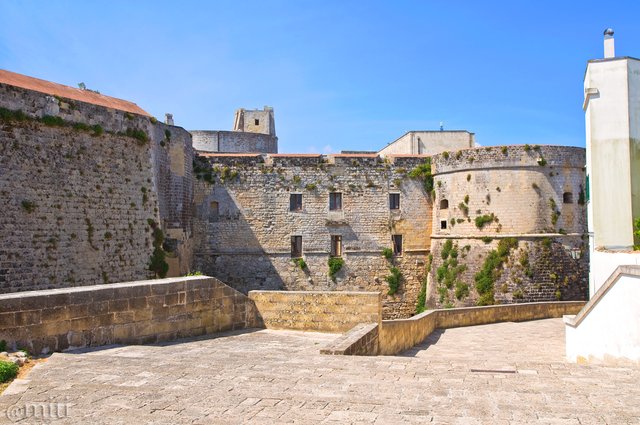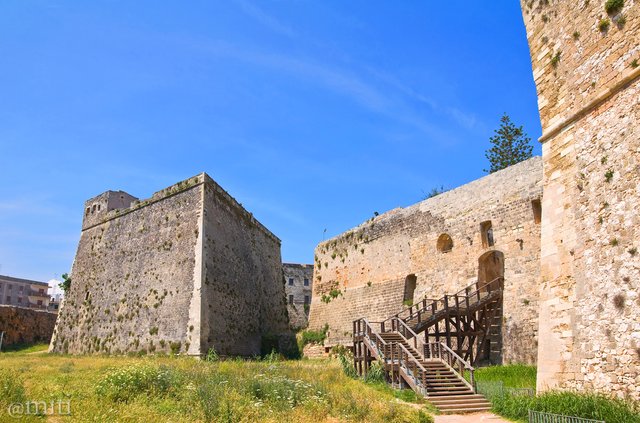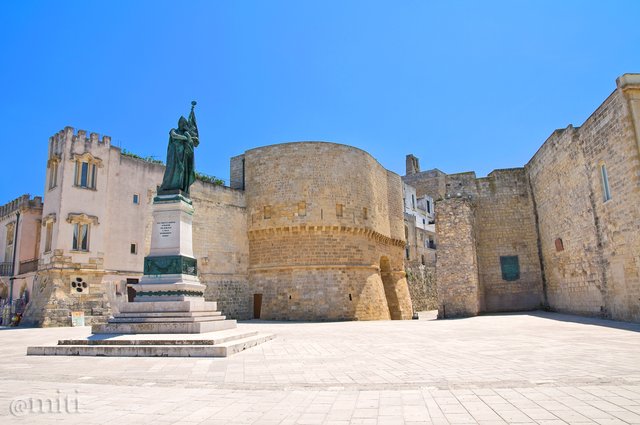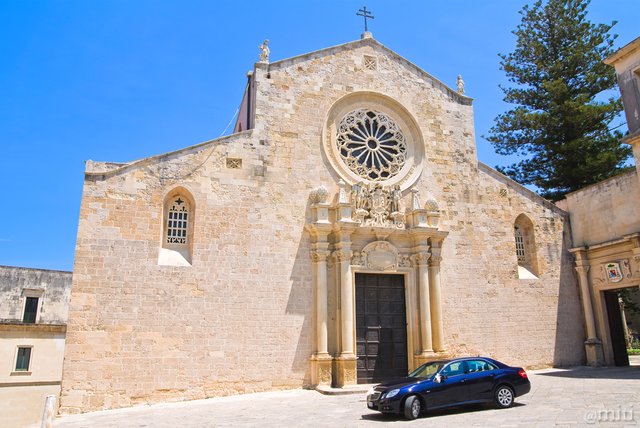
The Castle of Otranto (Author's photo - All rights reserved)
Il Castello di Otranto (Immagine dell'autore - tutti i diritti sono riservati)



Ciao a tutti,
questo è un viaggio attraverso l'Italia. Posterò una foto al giorno con una brevissima descrizione. Spero vi piaccia!
Questa è un'edizione speciale per festeggiare i 100 post di questa lunghissima serie! In questa occasione infatti ci saranno ben 4 foto a raccontare questo splendido posto!

Otranto è un borgo della provincia di Lecce, nella regione italiana meridionale della Puglia. È nella zona conosciuta come Salento, la punta della penisola che è il tacco dello stivale d'Italia. In una giornata limpida è possibile vedere oltre lo Stretto di Otranto l'Albania.
Otranto fu chiamata Hydruntum dai Romani dal fiume Idro (Hydrus), che scorre vicino al borgo e sfocia nel mare. Secondo l'ipotesi più accreditata il suo nome deriva dal greco ùdor kai derento, "acqua e montagna".
L'area di Otranto era già abitata durante l'età del bronzo e del ferro. Fu colonizzata dai Messapi e dai Greci e, durante il dominio romano, divenne un comune e una delle più importanti città marittime della Puglia.
Otranto fu oggetto di continui attacchi da parte dei turchi. Uno di quegli attacchi è ancora oggi ricordato come uno dei più sanguinosi di sempre. Nel 1480, un esercito ottomano inviato da Mehmed il Conquistatore catturò Otranto. Circa 800 cittadini, noti come i "Martiri di Otranto", furono decapitati dopo aver rifiutato di convertirsi all'Islam. Le ossa e i teschi dei martiri di Otranto sono ora conservati e protetti da un vetro nella cattedrale.
L'anno seguente, dopo aver causato molta distruzione, i Turchi abbandonarono la città.
A partire dalla seconda metà del Seicento, Otranto visse un netto declino della sua importanza. Il commercio era soggetto a un forte calo e le manifestazioni culturali erano quasi inesistenti. Molti degli abitanti di Otranto, ormai stanchi e impauriti dalle continue incursioni via mare, decisero di lasciare il paese e trasferirsi in luoghi più sicuri. Fu così che la città perse quel posto primario che occupava nel Salento. Il Settecento fu il secolo di una moderata ripresa, grazie alla presenza di alcune famiglie di altri centri di Terra d'Otranto che si trasferirono nel villaggio.
L'imponente Castello di Otranto (il Castello Aragonese) faceva parte delle forti difese di Otranto. Fu commissionato da Alfonso II di Napoli e costruito tra il 1485 e il 1492 sul sito delle antiche fortificazioni sveve. La struttura originale, con le sue torri circolari e il fossato circostante, fu modificata nel 1578, con l'aggiunta di un bastione a forma di diamante, destinato a identificare le navi predatrici.
All'interno, il cortile rettangolare ha una cappella a destra, e una scala a sinistra, che porta ai piani superiori e ai bastioni. In tutto il castello, le aperture nelle sue mura permettevano di puntare i cannoni in qualsiasi direzione. Sotto di esso, c'è un labirinto di cunicoli e e gallerie risalenti al 15 ° secolo.
Meritano sicuramente una visita la cattedrale di Otranto con il suo mosaico pavimentale, opera di Pantaleone, costruita sulla sommità di antichi insediamenti messapici e romani e durante il dominio normanno, intorno al XII secolo; fu dedicata a Santa Maria Annunziata. Il suo portale è circondato da una cornice decorata. Sopra di esso, un rosone in stile rinascimentale fu aggiunto nel 1481, subito dopo che gli invasori ottomani abbandonarono la città.
La basilica bizantina di S. Pietro è il luogo di culto più antico del paese e rappresenta una delle più grandi espressioni dell'arte bizantina di tutta la Puglia. La chiesa della Madonna dell'Altomare conserva un pavimento a mosaico e decorazioni che rimandano alla tradizione marinara. La fondazione del monastero di San Nicola di Casole risale al 1098 ed è stato uno dei luoghi più importanti del Salento dal punto di vista storico, culturale e artistico. Centro culturale molto attivo, conservò per lunghi secoli numerosi volumi latini e greci, che ne facero una delle biblioteche più ricche d'Europa. Distrutto nel 1480 in seguito alla devastazione dei turchi, rimane oggi sotto forma di rovine.
Oltre a queste attrazioni turistiche, i visitatori possono semplicemente passeggiare per le stradine del centro storico, attraversando scenari e scorci pittoreschi. Il centro è ancora racchiuso tra le sue mura difensive, il che dà un vero senso della storia.
Nei dintorni di Otranto ci sono anche numerose cripte e chiese rupestri molto interessanti come la cripta di San Nicola, situata nella Valle dei ricordi dove sorgeva un antico villaggio rupestre, con frammenti di affreschi bizantini in lingua greca. Vicino alla collina di Minerva, invece, si trova nella cripta del Padreterno interamente scavata nella roccia, lungo le cui pareti, interamente affrescate, si distribuisce il sedile in pietra per i fedeli. Sulla collina di San Giovanni si accede a un interessante complesso sotterraneo di catacombe paleocristiane.
Otranto appartiene al circuito de 'I borghi più belli d'Italia'. Ha anche ricevuto diverse Bandiere Blu (le spiagge più belle della Puglia).
Cose da vedere: Il Centro Storico, il Castello di Otranto, la Cattedrale di Santa Maria Annunziata, la Basilica di S. Pietro, la chiesa della Madonna dell'Altomare, il Monastero di San Nicola di Casole, le Mura difensive, la cripta di San Nicola, la cripta del Padreterno, l'ipogeo messapico nella Valle delle Memorie.

Hello everyone,
I began a Photo Journey through Italy. I will post one photo every day with a little note of explanation. I hope you like it!
This is a special edition to celebrate the 100th post of this very long series! On this occasion there will be not only one, but 4 photos to show this beautiful place!

Otranto is a town in the province of Lecce, in the southern Italian region of Puglia. It is within the area known as the Salento, the tip of the peninsula which is the heel of Italy's boot. On a clear day it is possible to see over the Strait of Otranto to Albania.
Otranto was called Hydruntum by the Romans after the river Idro (Hydrus), which flows near the borgo and empties into the sea. According to the most creditable hypothesis its name derives from the Greek ùdor kai derento, “water and mountain”.
The area of Otranto was already inhabited during the Bronze and Iron ages. It was colonised by the Messapians and by the Greeks and, during the Roman rule, it became a municipality and one of most important maritime cities of Puglia.
Otranto was subject to continual attacks by the Turks. One of those attacks is still remembered today as one of the bloodiest ever. In 1480, an Ottoman army sent by Mehmed the Conqueror captured Otranto. Some 800 citizens, known as the "Martyrs of Otranto," were beheaded after refusing to convert to Islam. The bones and skulls of the martyrs of Otranto are now stacked behind glass in the cathedral.
The following year, after causing much destruction, the Turks abandoned the town.
Starting from the second half of the Seventeenth Century Otranto lived a sharp decline of its importance. The trade was subject to a stop and cultural manifestations were almost non existent. Many of the inhabitants of Otranto, now exhausted and frightened by the continuous incursions by sea, decided to leave the country and move to safer places. So it was that the city lost that primary place they occupied in the Salento. The Eighteenth century was the century of a moderate recovery, thanks to the presence of some families of other centers of Terra d'Otranto that moved in the village.
The imposing Castle of Otranto (the Aragonese Castle) was part of the tough defences of Otranto. It was commissioned by Alfonso II of Naples, and built between 1485 and 1492 on the site of former Swabian fortifications. The original structure, with its circular towers and surrounding moat, was altered in 1578, with the addition of a diamond-shaped bastion, intended to identify marauding ships.
Inside, the rectangular courtyard has a chapel to the right, and a staircase to the left, which leads to the upper floors and battlements. Throughout the castle, openings in its walls allowed for cannons to be pointed in any direction. Underneath it, there is a maze of tunnels and galleries dating back to the 15th century.
Certainly deserve a visit to the cathedral of Otranto with its mosaic floor, work of Pantaleone, built on top of ancient Messapian and Roman settlements, was constructed during Norman rule, around the 12th century, and dedicated to Santa Maria Annunziata. Its portal is surrounded by a decorated frame. Above it, a Renaissance style rose window was added in 1481, soon after the Ottoman invaders abandoned the city.
The Byzantine Basilica of S. Pietro is the most ancient place of cult of the village and represents one of the greatest expressions of Byzantine art of the whole puglia. The church of the Madonna of the Altomare preserves a mosaic floor and decorations reminiscent of the seafaring tradition. The foundation of the monastery of San Nicola di Casole dates back to 1098 and was one of the most important places of the Salento from the point of view of historical, cultural and artistic. Very active cultural center, preserved for long centuries numerous volumes Latin and Greek, which made it one of the libraries the richest in Europe. Destroyed in 1480 following the devastation of the Turks, it remain today only ruins.
In addition to these tourist sights, visitors can simply roam the lanes of the historic town, coming across picturesque scenes and views. The centre is still enclosed within its defensive walls, which gives a real sense of history.
In the surroundings of Otranto there are also numerous crypts and rupestrian churches very interesting as the crypt of San Nicola, situated in the Valley of the memories where stood an ancient rock village, with fragments of byzantine frescoes and frescoes in the Greek language. Near the hill of Minerva, instead, is located in the crypt of the Padreterno entirely carved into the rock, along whose walls, entirely frescoed, distributes the stone seat for the faithful. On the hill of San Giovanni is accessing an interesting underground complex of paleochristian catacombs.
Otranto is one of Italy's most beautiful villages ('I borghi più belli d'Italia'). It has also been awarded the Blue Flags (Puglia's most beautiful beaches).
Thing to see: The Historic Centre, the Castle of Otranto, the Cathedral of Santa Maria Annunziata, the Basilica of S. Pietro, the church of the Madonna of the Altomare, the Monastery of San Nicola di Casole, the Defensive Walls, the crypt of San Nicola, the crypt of the Padreterno, the Messapic hypogeum in the Valle delle Memorie.

| Tipo di foto / Category | Paesaggio / Landscape view |
| Esposizione / Settings | 1/250 sec, ISO 200, f/10 |
| Camera | Nikon D5000 |
| Lente / Lens | Tamron SP 17-50mm f/2.8 XR Di II LD |
| Filtro / Filter | Polarizzatore Hoya / Hoya Polarizing filter |
| Cavalletto / Tripod | Manfrotto MKC3-P01 |
| Località / Location | Otranto (Lecce), Italia |
| Software | Photoshop |


The Castle of Otranto (Author's photo - All rights reserved)
Il Castello di Otranto (Immagine dell'autore - tutti i diritti sono riservati)

Otranto Defensive Walls (Author's photo - All rights reserved)
Le mura dfifensive di Otranto (Immagine dell'autore - tutti i diritti sono riservati)

The Cathedral of Santa Maria Annunziata (Author's photo - All rights reserved)
La Cattedrale di Santa Maria Annunziata (Immagine dell'autore - tutti i diritti sono riservati)
lovely sunshine
Downvoting a post can decrease pending rewards and make it less visible. Common reasons:
Submit
This is pretty cool... the environment looks quite neat and arranged, can't love this any less.
Downvoting a post can decrease pending rewards and make it less visible. Common reasons:
Submit
i agree with you....excellent photography... so pretty
Downvoting a post can decrease pending rewards and make it less visible. Common reasons:
Submit
And thank you, too.
Downvoting a post can decrease pending rewards and make it less visible. Common reasons:
Submit
Thanks
Downvoting a post can decrease pending rewards and make it less visible. Common reasons:
Submit
Congratulations, Your Post Has Been Added To The Steemit Worldmap!
Author link: http://steemitworldmap.com?author=miti
Post link: http://steemitworldmap.com?post=a-journey-through-italy-one-photo-every-day-100-special-edition-otranto-eng-ita
Want to have your post on the map too?
Downvoting a post can decrease pending rewards and make it less visible. Common reasons:
Submit
Ciao @miti! I tuoi post sono come ricevere delle bellissime cartoline ogni giorno :) Splendida Otranto, ce l'ho nel cuore <3 Spero di avere presto occasione di tornarci. Un abbraccio estivo :*
Downvoting a post can decrease pending rewards and make it less visible. Common reasons:
Submit
Ciao Isa, grazie! Un abbraccio anche a te ;-)
Downvoting a post can decrease pending rewards and make it less visible. Common reasons:
Submit
Very beautiful picture.......sir
You are a amazing photographer
Downvoting a post can decrease pending rewards and make it less visible. Common reasons:
Submit
You got a 31.91% upvote from @ocdb courtesy of @miti!
Downvoting a post can decrease pending rewards and make it less visible. Common reasons:
Submit
Excellent article. I really liked it. Good luck to you and Love.
Downvoting a post can decrease pending rewards and make it less visible. Common reasons:
Submit
yes...i agree with you..execellent pgography & article....very helpfull thing
Downvoting a post can decrease pending rewards and make it less visible. Common reasons:
Submit
very helpfull post....Excellent artical & awesome photography
Downvoting a post can decrease pending rewards and make it less visible. Common reasons:
Submit
Thanks
Downvoting a post can decrease pending rewards and make it less visible. Common reasons:
Submit
Beautiful. Congrats on 100 posts in this series! I think it’s awesome that you share a little piece of our beautiful country that people wouldn’t otherwise go see as a tourist. I as well as others will certainly refer to your blog, when we go visit, for ideas!
Downvoting a post can decrease pending rewards and make it less visible. Common reasons:
Submit
Thanks, you're so kind ;-)
Downvoting a post can decrease pending rewards and make it less visible. Common reasons:
Submit
Its unique photography. I love visiting one day:)
Downvoting a post can decrease pending rewards and make it less visible. Common reasons:
Submit
Nothing is impossible ;-)
Downvoting a post can decrease pending rewards and make it less visible. Common reasons:
Submit
Sure
Downvoting a post can decrease pending rewards and make it less visible. Common reasons:
Submit
@miti you were flagged by a worthless gang of trolls, so, I gave you an upvote to counteract it! Enjoy!!
Downvoting a post can decrease pending rewards and make it less visible. Common reasons:
Submit
Beautiful photos, very interesting view of this castle
Downvoting a post can decrease pending rewards and make it less visible. Common reasons:
Submit
Thanks
Downvoting a post can decrease pending rewards and make it less visible. Common reasons:
Submit
#ita
Congratulazioni! Il tuo post è stato votato perchè utilizza il tag #italy e contribuisce alla divulgazione dell'Italia su Steem.
Clicca sulla bandiera per vedere altri post taggati allo stesso modo!
#en
Congratulations! Your post has been upvoted because it uses the tag #italy and contributes to sharing Italy on Steem .
Click on the italian flag to see other posts tagged the same way!
Downvoting a post can decrease pending rewards and make it less visible. Common reasons:
Submit
Per favore, non commentare più i miei post con questi messaggi inutili o dovrò prendere provvedimenti.
Downvoting a post can decrease pending rewards and make it less visible. Common reasons:
Submit
Ok ho visto che un altro utente lo faceva per il Portogallo e ho pensato che fosse una buona idea siccome mi ha fatto piacere quando ho pubblicato le foto.
Smettero di commentare i tuoi post come mi hai chiesto.
Downvoting a post can decrease pending rewards and make it less visible. Common reasons:
Submit
Si, ma è troppo "evidente" nella sezione commenti, con quell'enorme bandiera e poi altro non è che un link alla trending page e non un qualcosa di elaborato. Insomma, una cosa abbastanza inutile... scusa la franchezza.
Downvoting a post can decrease pending rewards and make it less visible. Common reasons:
Submit
What's the beauty! And that beauty establish through a professional & expert hand obviously.
Downvoting a post can decrease pending rewards and make it less visible. Common reasons:
Submit
Thanks
Downvoting a post can decrease pending rewards and make it less visible. Common reasons:
Submit
Downvoting a post can decrease pending rewards and make it less visible. Common reasons:
Submit
wow i love you photography. im a little photographer . feel free to visite my vlog please
Downvoting a post can decrease pending rewards and make it less visible. Common reasons:
Submit
You beg for visit your vlog, didn't upvote my post and upvote your comment? NO, I don't do these kind of things.
Downvoting a post can decrease pending rewards and make it less visible. Common reasons:
Submit
Nce
Plz upvte me nd cmmnt
Downvoting a post can decrease pending rewards and make it less visible. Common reasons:
Submit
Your comment is considered SPAM... Take a look in this guide:
https://steemit.com/steemit/@miti/a-complete-guide-for-newcomers-and-minnows-to-avoid-a-possible-spam-and-to-write-good-comments
It will help you.
Downvoting a post can decrease pending rewards and make it less visible. Common reasons:
Submit